This entry includes a walking tour! Take the tour.
Introduction
Text-to-speech Audio
The cornerstone for today’s IU Health Methodist Hospital was set in place on October 25, 1905. Over the next century, the hospital expanded to become a founding member of IU Health, the largest private health care system in Indiana. Methodist had many firsts throughout its history, including the first insulin trial in the Midwest (1922) and the first successful heart transplant outside of a medical school setting (1982).
Images
Ariel Photo of Methodist Hospital 2003
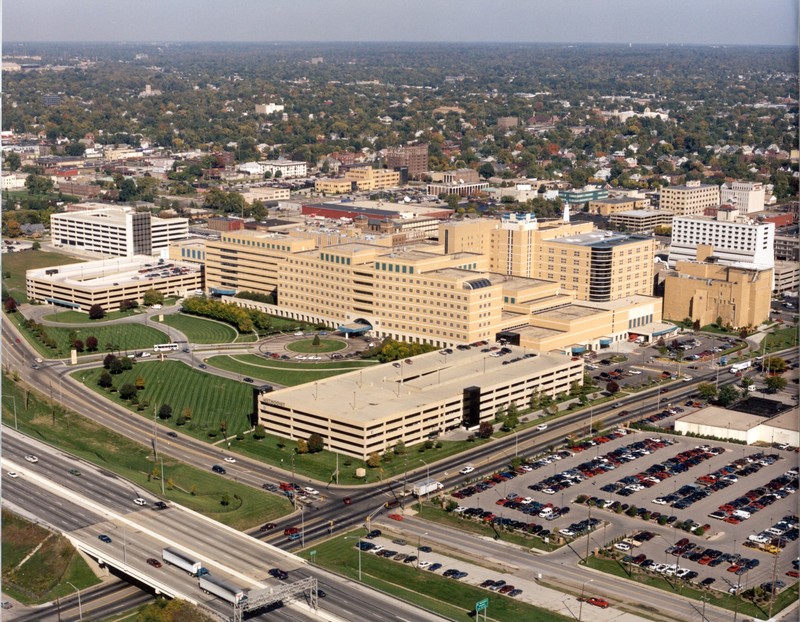
Noyes Children's Pavilion Interior
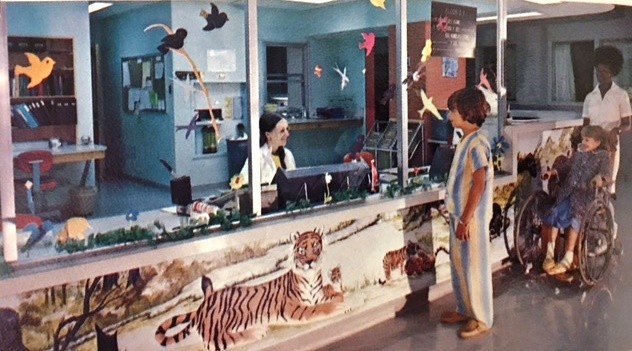
Clarian Health People Mover
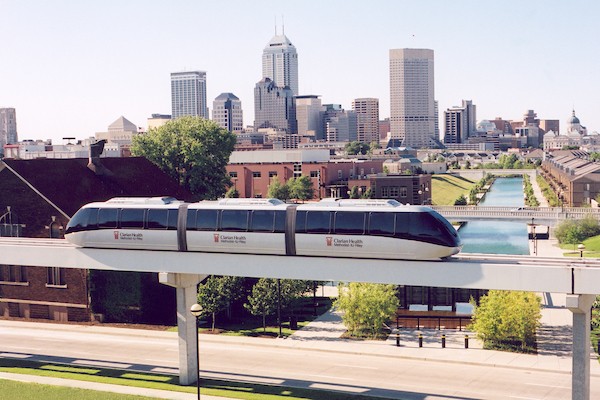
Methodist Hospital ER and East Tower
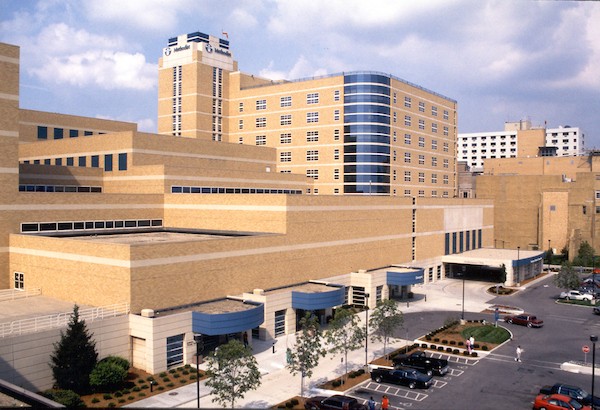
West Tower Construction
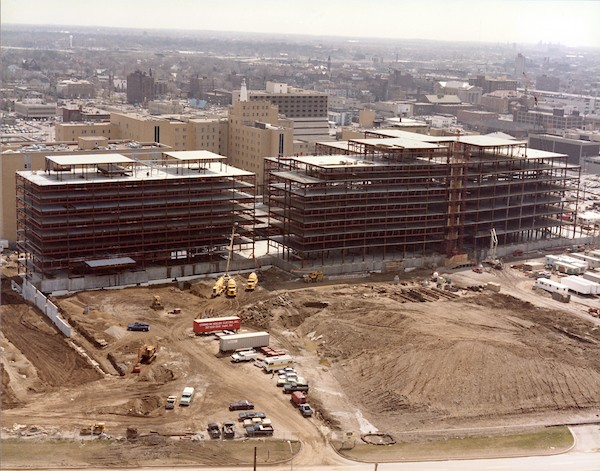
IU Health System Wide Map
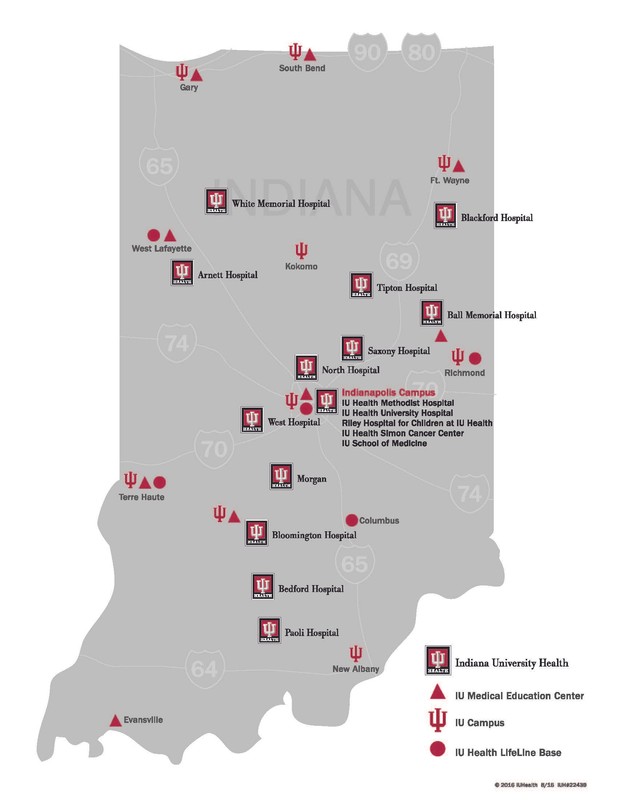
Backstory and Context
Text-to-speech Audio
In 1880, due to rampant disease, only three cities in the country had a higher death rate than Indianapolis. As a result, the Indianapolis Methodist Church recognized the necessity for medical care in the community and began formulating a plan for a hospital during their 1899 Indianapolis Epworth League Convention. The convention allocated their surplus of $4,750 to seed the hospital. The money created a strong foundation for the project but was not enough to build a hospital. Thus, a Methodist Hospital Board of Trustees was established to oversee and fundraise for the new project. It took another six years of fundraising before construction began.
The original plan was to have the hospital located outside the city center, but because of backlash from city doctors, the Board decided to locate the hospital on the corner of Capitol Avenue and 16th Street. In 1905, the Board hosted a gala for the Hospital’s groundbreaking with the Vice President of the United States, Warren Fairbanks, and U.S. Senator from Indiana, Albert Beveridge, in attendance. Three years later, the three-story fireproof Methodist Episcopal Hospital and Deaconess Home opened with 65 beds. Within twelve years, the Hospital expanded with the addition of the Mary S. Yount Pavilion in 1912 and the North Wing in 1916.
In 1922, Methodist Hospital was one of the first medical institutions to test insulin on patients with diabetes because of their partnership with pharmaceutical company Eli Lilly. This partnership established the hospital as a pioneer in early studies of diabetes, which was, at the time, a death sentence for anyone who had it. As a result of their pioneering efforts, Methodist Hospital entered the national and world stage of medical science.
In 1928, the Hospital continued expanding with the construction of Jacob E. Wile Memorial Hall, a home for the growing Methodist Hospital School of Nursing. In 1930, the Hospital expanded again with the Julius A. Hanson Memorial Unit. With the opening of this new unit, Methodist Hospital became one of the six largest hospitals in the world. In the early 1930s, Methodist Hospital dedicated the Mary Hanson Cary Chapel and erected the iconic Lighthouse of Health beacon on the roof of the B Building.
In the 1940s and 1950s, Methodist Hospital established itself as one of the nation’s leading hospitals by installing one of the first electroencephalograph machines to diagnose brain tumors, epilepsy, and other brain conditions. In 1957, Methodist announced an extensive building expansion program. The project would take over three years to add a 208-bed general hospital unit to the west side of the B building, expand the central wing of the Hospital, and add a new psychiatric facility, today known as the C building.
The 1960s was a decade of expansion for Methodist Hospital. Along with expanding the intensive care unit in 1963, Methodist Hospital built two new structures and expanded existing ones. In 1965 the Krannert Tower opened, and in 1967 the Noyes Pavilion opened. The Noyes Pavilion provided medical care to infants and children to the age of 14 years. In the late 1960s, a major update to the main entrance and administrative area presented a modernized appearance to the public along Capitol Avenue. The addition created more space for administrative offices, a larger waiting room, and a more modern appearance for the main entrance. The C building also grew vertically by six floors during the 1960s.
In 1972, Methodist Hospital became the first hospital in Indiana to perform a kidney transplant and one of the first private hospitals in the nation to develop an organ transplant program. Methodist Hospital was continually on the cutting edge of medical technology, showing their commitment to advancing medical education. In 1976, the Hospital continued expanding by constructing the twelve-story medical tower built across Capitol Avenue; the new structure is connected to the main hospital by a skywalk.
The 1980s was a decade of firsts for medical operations in Indiana. In 1982, Mrs. Annie Gardner was Methodist Hospital’s first heart transplant patient. Methodist was the first hospital in the Midwest to perform such an operation and the first to do it in a non-medical school setting. Methodist was also the first in the nation to use an extracorporeal shock wave lithotripter to pulverize kidney stones, and the first in Indiana to implant an artificial heart. Amid all the firsts, Methodist expanded with the construction of A Building West and moved the main entrance from Capitol Avenue to a relocated Senate Boulevard facing I-65.
In 1997, Methodist Hospital, Indiana University Hospital, and Riley Hospital for Children consolidated to form Clarian Health Partners. Their goal was to provide integrated, seamless health care for the state of Indiana. The organization began partnerships with over 16 other regional hospitals and health care systems over the next decade. In 2003, the people mover tram system was erected in Indianapolis to physically connect University Hospital, Methodist, and Riley Children’s Hospital. The people mover was a tangible example of a long-term commitment between these hospitals to work together. In 2011, Clarian rebranded to what it is known as today, IU Health to reinforce their partnership with Indiana University and the IU School of Medicine.
To learn more about Methodist Hospital’s storied history, begin the walking tour connected to this entry.
Timeline of Methodist Hospital’s Expansion
- 1908 – Methodist Episcopal Hospital and Deaconess Home opened.
- 1912 – Completion of the Mary S. Yount Pavilion (South Wing of the Hospital)
- 1916 – the North Wing of the Hospital is Dedicated
- 1928 – Construction of Wile Hall is completed.
- 1930 – Dedication of the Julius A. Hanson Unit
- 1933 – The Beacon of Health is installed on top of the Hanson Unit
- 1956 – Methodist Hospital purchases Riley Hotel; it later becomes Wesley Hall and housed nursing students
- 1959 – Opening of the C Building
- 1965 – Construction of the Krannert Tower
- 1967 – opening of the Methodist Children’s Pavilion; Later renamed Marguerite Lilly Noyes Children’s Pavilion in 1985
- 1968 – A six story addition to the C building
- 1976 – Construction of the twelve-story medical tower that is connected to the hospital by a skywalk
- 1978 – Wesley Hall Demolished
- 1982 – Completion of the Energy (Facilities) Center
- 1986 – Methodist Hospital A Building West opens and the entrance is moved from Capitol Avenue to Senate Boulevard
- 1989 – Krannert Tower and south wing of the original hospital demolished to make room for A Building East
- 1995 – A Building East dedicated
- 2003 – People mover tram system installed between University Hospital, Riley Hospital, and Methodist Hospital
- 2012 – Neuroscience Center opens and is connected to Methodist Hospital by a skywalk over 16th Street
- 2020 – Plans announced to consolidate all adult health care into an IU Health Adult Academic Health Center. Located on the southwest corner of 16th street and Capitol Avenue, the new facility will have 700 beds and be over two million square feet.
- 2021- Construction on the new Adult Academic Health Center begins
Sources
Reed, Kenneth E. and Leary, Edward A. A History of Methodist Hospital of Indiana Inc.: A Mission of Compassionate Heath Care. Indianapolis, IN, 2007 https://indianamemory.contentdm.oclc.org/digital/collection/HIUH/id/556
Newspapers Consulted:
Indianapolis Star
Indianapolis News
Materials in IU Health Archives Consulted:
Board and Committee Minutes
The Beacon Newsletter
IU Health Archives
IU Health Archives
IU Health Archives
IU Health Archives
IU Health Archives
IU Health Archives

